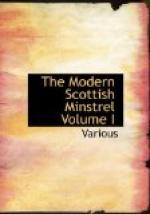Subsequent to the appearance of “The Scottish Minstrel,” Lady Nairn did not publish any lyrics; and she was eminently successful in preserving her incognita. No critic ventured to identify her as the celebrated “B. B.,” and it was only whispered among a few that she had composed “The Land o’ the Leal.” The mention of her name publicly as the author of this beautiful ode, on one occasion, had signally disconcerted her. While she was resident in Paris, in 1842, she writes to an intimate friend in Edinburgh on this subject:—“A Scottish lady here, Lady——, with whom I never met in Scotland, is so good as, among perfect strangers, to denounce me as the origin of ‘The Land o’ the Leal!’ I cannot trace it, but very much dislike as ever any kind of publicity.” The extreme diffidence and shrinking modesty of the amiable author continued to the close of her life; she never divulged, beyond a small circle of confidential friends, the authorship of a single verse. The songs published in her youth had been given to others; but, as in the case of Lady Anne Barnard, these assignments caused her no uneasiness. She experienced much gratification in finding her simple minstrelsy supplanting the coarse and demoralising rhymes of a former period; and this mental satisfaction she preferred to fame.
The philanthropic efforts of Lady Nairn were not limited to the purification of the national minstrelsy; her benevolence extended towards the support of every institution likely to promote the temporal comforts, or advance the spiritual interests of her countrymen. Her contributions to the public charities were ample, and she
“Did good by stealth, and blush’d to find it fame.”
In an address delivered at Edinburgh, on the 29th of December 1845, Dr Chalmers, referring to the exertions which had been made for the supply of religious instruction in the district of the West Port of Edinburgh, made the following remarks regarding Lady Nairn, who was then recently deceased:—“Let me speak now as to the countenance we have received. I am now at liberty to mention a very noble benefaction which I received about a year ago. Inquiry was made at me by a lady, mentioning that she had a sum at her disposal, and that she wished to apply it to charitable purposes; and she wanted me to enumerate a list of charitable objects, in proportion to the




